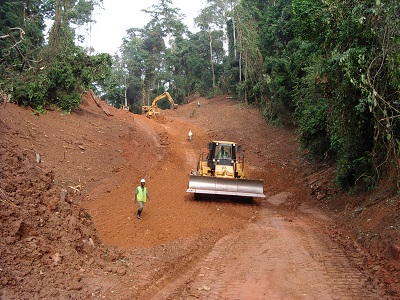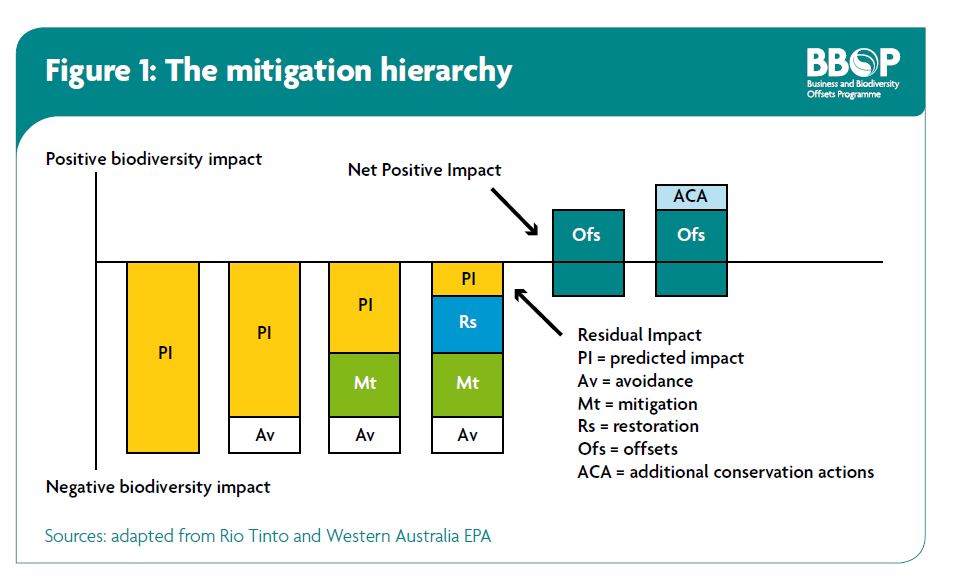Changes to the natural environment resulting from company actions will lead to new or elevated risks to local communities. Land-use changes more often than not affect local food production and food security. Loss of natural buffer areas such as the wetlands, mangroves, and upland forests that mitigate the effects of weather related hazards - flooding, landslides, and fire - has a tendency to increase vulnerability and community safety-related risks and impacts. Reduction of the quality, quantity, and availability of freshwater and other natural resources is likely to create health-related risks and impacts. How these translate into impacts depends on the effectiveness of plans and activities aimed at reducing, remediating and offsetting.
Environment
-
Intro

-
Guide
- The risk and impact-identification process needs to be based on recent environmental and social baseline data at the appropriate level of detail;
- If there is a possibility you will create significant impacts or where technically complex issues are involved you need to involve external experts to assist in the risk and impact-identification process;
- Baseline studies typically comprise some combination of literature review, consultation and in-field surveys. If your project has the potential for significant impacts, the baseline will need to include in-field surveys over multiple seasons and be conducted by competent professionals and external experts. In-field surveys/assessments need to be recent and the data acquired for the actual site of your project’s facilities, including related and associated facilities, as well as the project’s area of influence.
- Design and operate your project to minimize the use of key inputs water, energy, land and reagents and the generation of waste, effluent and emissions;
- Aim to reduce water consumption and recycle as much as possible;
- If possible, align with host government water management plans and practices and manage watersheds collaboratively;
- Consider incorporating renewable energy into the operational mix.
- It is never too early to start;
- Share information about potential impacts and your plans for managing the associated risks with local communities and national agencies. School based programs targeting the physical environment – weather, water, noise and dust can be effective and are relatively easy to get up and running;
- Remember - environmental management is more than a technical issue. It also requires a good understanding of the social and cultural processes through which communities experience, perceive, and respond to risks and impacts. Community perceptions are often conditioned less by technical or quantitative assessments, and more by the ways in which community members experience change.
- Exposure of soil surfaces to rain and wind during site clearing, earth moving, and excavation activities and the resultant mobilization and transport of soil particles may, in turn, result in sedimentation of surface drainage networks, impacting the quality of natural water systems and ultimately the user of these waters;
- New water bodies, such as surface-water environmental-control dams or new reservoirs, may become magnets for local community members and increase the risks of injury, including accidental drowning;
- In addition, water storage facilities require careful environmental engineering (for example, shoreline slopes and vegetation control) to prevent development of vector -breeding sites;
- During construction and operations phases, tyres, drums, and other containers may become significant breeding sites for mosquitoes, with subsequent increased risk of malaria and dengue fever outbreaks;
- Resettlement and relocation communities may be in closer proximity to water bodies, which will significantly increase the vector-borne disease risk.
- Involvement in scientific sampling methods and analysis – you will find that some local groups will be perfectly capable of understanding the techniques without professional training while others may need some capacity building;
- observations by affected people;
- group discussions on the success of mitigation or benefit measures and/or on how to manage new issues that have arisen;
- adapting commonly used participatory techniques to assess changes in the physical and socio-economic environment over time.
Guide to Environmental Management
WHY ENVIRONMENTAL MANAGEMENT MATTERS:
Changes to land-use are unavoidable whatever the nature of the new end-use you are planning. Whether it is a new mine, a solar power project, a wind farm or a commercial plantation more often than not the consequence of change will be less local food production and poorer food security. The consequence of the loss of natural buffer areas such as the wetlands, mangroves, and upland forests that mitigate the effects of weather related hazards - flooding, landslides, and fire - will likely increase community vulnerability and safety related risks and impacts. Reduction of the quality, quantity, and availability of freshwater and other natural resources is likely to create health-related risks and impacts. When it is not feasible to avoid environmental impacts you will need to build in engineering and management controls to minimise the undesirable consequences for your local communities.
WHAT TO DO:
HOW TO DO IT:
Identify Environmental Risks and Impacts
Minimize resource use and waste Educate
WHAT ELSE YOU CAN DO:
Water Management: Groundwater and surface water are often essential sources of drinking and irrigation water in many countries, particularly in rural areas where piped water supply may be limited or unavailable and there is little or no treatment before consumption. Activities involving wastewater discharges, water extraction, diversion or impoundment will need to aim to prevent impacts to the quality and availability of groundwater and surface water resources and where this is not possible, alternative sources must be provided. Other ways projects impact water resources include:Addressing Biodiversity: Protecting and conserving biodiversity and sustainably managing living natural resources is very much on the radar of NGO, lenders and local communities alike. An increasingly common approach to managing biodiversity impact is through application of biodiversity offsets using a mitigation hierarchy similar to those used for other project risks – from avoid, through mitigate to restore to benefit or to go the extra mile and offset.How big an issue biodiversity management will be for you will become apparent early in your environmental and social impact assessment studies. Often local people have a better understanding about their own environment than company-appointed ‘experts’, so involve local communities in biodiversity efforts and build on local knowledge whenever you can.Participatory Monitoring: One way to help satisfy concerns and create a common understanding is to involve local people in monitoring the implementation of mitigation measures or other environmental and social programs. Participation, and the flow of information generated through the process can also encourage local people to take a greater degree of responsibility for their environment and welfare in relation to the project, and to feel ownership and empowerment and that they can do something practical to address issues that affect their lives. Participatory monitoring also tends to strengthen relationships between the project and its local communities. If local capacity is lacking, you will need to consider capacity-building and training programs to enable individuals or local organizations to acquire the technical skills necessary to participate in effective monitoring. Companies which have done so say it is in their own best interests to ensure that any groups monitoring their project have a sound technical understanding of the process, as it leads to more accurate and credible monitoring results and enables informed dialogue.Participatory monitoring might include:While you may be sceptical about the ability of local people to assist in monitoring, many companies who have tried this approach have found the learning curve to be much quicker than they had thought..Climate Change: Climate change is real and it is incumbent on you and your company to consider the implications in planning and design. This can be done by using scenario planning to inform yourself on climate and energy risks and opportunities and by using climate predictions in the design and placement of infrastructure such as tailings storage facilities and water reservoirs. You might also want to keep climate change on the radar of senior managers and board members by including it as an HSEC agenda item. -
More Resources
- Getting more from your baseline studies
-

If you are serious about managing social risk then establishing a quality social baseline is an absolute necessity. After all, if you don’t know the starting point you can’t measure the change...
- IFC PS3: Resource Efficiency and Pollution Prevention.
-
Industrial activity and urbanization can increase levels of pollution that may threaten people’s health and the environment. PS3 guides companies to integrate practices and technologies that promote energy efficiency, use resources—including energy and water—sustainably, and reduce greenhouse gas emissions.
The standard and guideline make for a good starting point for a novice. The IFC website has these and other useful resources available for downloading:
https://www.ifc.org/en/insights-reports/2012/ifc-performance-standard-3
- IFC PS6: Biodiversity Conservation and Sustainable Management of Living Natural Resources
-
Biodiversity loss can result in critical reductions in the resources provided by the earth’s ecosystems, which contribute to economic prosperity and human development. This is especially relevant in developing countries where natural resource-based livelihoods are often prevalent. PS6 recognizes that protecting and conserving biodiversity, maintaining ecosystem services, and managing living natural resources adequately are fundamental to sustainable development.
The IFC website has useful resources available for downloading: https://www.ifc.org/en/insights-reports/2012/ifc-performance-standard-6
- IFC Webinar: Performance Standards 101
-
A good way to spend an hour getting an introduction to how the performance standards work.
You'll find more useful IFC-generated information here.
- Zandvliet and Anderson: Getting It Right
-
This book has been written for corporate managers who are responsible for company operations in societies that are poor and politically unstable. Many such managers are frustrated with the situations they face. They try their best to run effective, profitable and beneficial operations that take account of the needs of all their stakeholders, including local surrounding communities. But, even with their best efforts, they encounter community dissatisfaction, unrest, opposition, and delays and, worse yet, threats and violence. Why does this happen?
I was fortunate to have the opportunity to work with Luc while I was feeling my way during my early days in Ghana and am forever thankful for the lesson (obvious with the benefit of hindsight) that resource development by default creates tension and conflict, and that it is how companies approach conflict – as an opportunity or as a threat – that shapes the ongoing relationship between company and community. Some of the ideas in the book have been particularly sticky:
- Relationships matter – at a personal and business level this seems a no-brainer but sometimes the connection seems to get lost when it comes to communities
- Company impacts are never neutral – they can be negative or positive but from the time a company starts work on-the-ground it starts to create change
- People everywhere get annoyed about the same issues – this one gave me a lot of comfort that I could be confident applying the ideas to my particular circumstances plus, the issues are not complicated – behaving appropriately, taking responsibility for impacts and fair distribution of benefits are the keys
- Relationships require ongoing effort – again not really earth-shattering news, so it is somewhat surprising how often it happens that over time we take things for granted and it takes a nasty wake-up call to show us how far we’ve gone off the rails
- Company actions shape the nature of relationships – this last one relates back to the third point, because the reality is that the three issues that most influence a relationship - impacts, benefits and behaviour – are all company-initiated actions, and it is totally within the company’s control to determine what it is going to do and how it is going to act
You can find (and buy) the book online.
